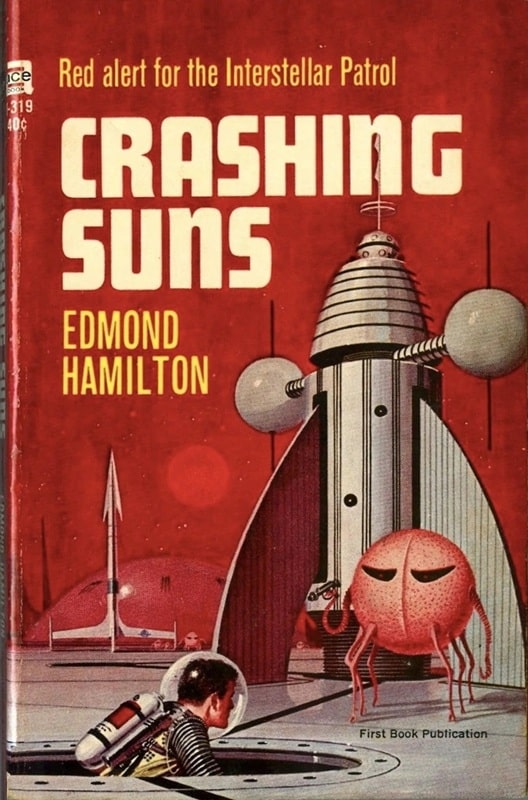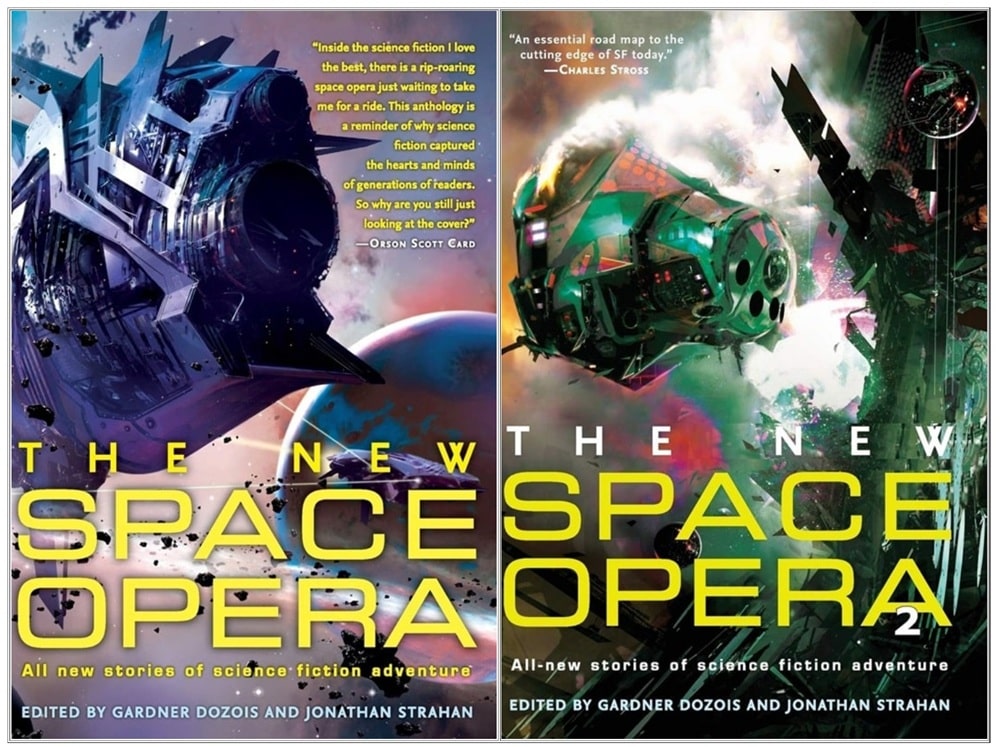The Sword & Planet of Edmond Hamilton, Part I
 |
 |
Crashing Suns by Edmond Hamilton (Ace Books, 1965). Cover by Ed Valigursky
Edmond Hamilton, who I’ve mentioned here before as Leigh Brackett’s husband, wrote mostly Science fiction and I consider him one of the first generation of Space Opera writers. And one of the best of the bunch. You might wonder what Space Opera is and how it differs from Sword & Planet fiction, as well as from more mainstream SF. Well, let me explain.
Space Opera was coined to be used pejoratively, to denigrate a certain type of SF in which action and drama were king. This type of story supposedly only used the trappings of SF to tell an adventure tale rather than engaging with futuristic ideas. And the trappings included such things as ray guns, faster-than-light travel, and space battles.
[Click the images for planet-sized versions.]

I never found the term pejorative; I sought out this kind of fiction, and I never linked it with “soap” opera, which it was supposed to reflect, but more with opera in the grand sense of classics like Macbeth. (If you think Shakespeare didn’t write melodrama, I don’t know what to tell you.)
In movies and TV, Star Wars is space opera. Star Trek, my favorite TV franchise, pretty much obliterates the line between Space Opera and straight SF, although my favorite episodes lean toward the space opera side.
My introduction to Space Opera came as a teenager when I read Crashing Suns by Edmond Hamilton, which featured five stories of the “Interstellar Patrol.”

The included stories were,
“Crashing Suns” (Weird Tales, August 1928)
“The Star Stealers” (Weird Tales, February 1929)
“Within the Nebula” (Weird Tales, May 1929)
“The Comet Drivers” (Weird Tales, February 1930)
“The Cosmic Cloud” (Weird Tales, November 1930)
These had been published in the late 1920s in Weird Tales, but I read them in the 1965 book shown above, from Ace Books. And I adored them.
Hamilton also wrote Sword & Planet fiction, however, and I’ve read it and enjoyed it. In one of my early posts here at Black Gate on June 10th, I wrote about an anthology called Swordsmen in the Sky, which helped ignite my lifelong love of Sword & Planet fiction. The last story in that collection was “Kaldar, World of Antares,” by Edmond Hamilton.
 |
 |
Magic Carpet Magazine, April 1933, containing “Kaldar, World of Antares.” Cover by Margaret Brundage
I didn’t find out until many years later that there were two other stories in the series. I managed to find and read them online.
They are,
“Kaldar, World of Antares” (Magic Carpet Magazine, April 1933)
“Snake-Men of Kaldar” (Magic Carpet Magazine, October 1933)
“The Great Brain of Kaldar” (Weird Tales, December 1935)
Covers of all these mags are shown above and below, though I don’t own these.
 |
 |
Magic Carpet Magazine, October 1933, and Weird Tales, December 1935. Covers by Margaret Brundage
There is a hardback that collects the three tales, along with an introduction by Ray Bradbury and an afterword by Hamilton himself, which was published by Haffner Press in 1998.
However, this routinely runs into the hundreds of dollars for a copy so I haven’t pulled the trigger on buying it. 1998 wasn’t that long ago so I hold out hope I might find it at a library book sale sometime for considerably cheaper. I’ve read the stories but would be interested in the introduction and afterword.
Read Part II of The Sword & Planet of Edmond Hamilton here.
Charles Gramlich administers The Swords & Planet League group on Facebook, where this post first appeared. His last article for Black Gate was a look at Flash Gordon.
Great stuff! That cover of Crashing Suns in particular raised a bunch of memories.
Haffner Press put out a slim trade paperback of the Kaldar stories, as a premium in his massive (still unfinished, I think) project to publish Hamilton’s collected fiction. But it seems to be so rare that Biblio, Alibris, etc. are unaware of its existence.
I do love Hamilton’s work: S&P, space opera, fantasy, comics—whatever. As a kid I was very fond of the more science-fictiony Superman stories (e.g. “Superman Under the Red Sun”), and only found out a few years ago that Hamilton wrote some of those.
DMR Press has done good work bringing Hamilton’s mythological fantasies back into print.
I have the collected Kaldar stories in a collection from Fiction House called Kaldar World of Antares. I haven’t seen the Haffner press pub but it sounds cool.
I’ve seen the ads that played a big part in giving us the phrase, and they actually compared science fiction to a melodramatic style of Westerns—”horse opera.” Back in those days, a lot of readers would have contrasted writers such as E.E. Smith to “space opera,” seeing them as more serious science fiction writers; the usage has changed over the decades.
I do know of the connection to horse opera. I think, too, there was a difference in how the term was used for books and for film/TV. By the time I started reading this stuff, mostly in the early 70s, I saw the term being used disparagingly but I liked it quite a lot. I know that today it seems most folks consider Smith and Hamilton to be the founders of Space opera, and they tend to emphasize different aspects of it. Smith was more about huge space fleets and battles and Hamilton generally more about smaller scale stories–at least in the settings. The stories still had world spanning connections.
I love the so-called “Space Opera” – one of the reasons I loathe these neologisms like “-Punk” slapped on to define genres is it creates expectations and limits. In the case of “Space Opera” it was obviously intended to be destructive. A few editors had obviously got bored of endless space adventure stories and wanted more hard science fiction. That was really the Campbell era which of course brought its own limits and biases with it. Then when Star Wars and Star Trek made science fiction be it Adventure themed or more “Hard” and true science fiction (vs scifi adventure) into the mainstream they were either rutting in late cambpell era or weirdzo “New Wave” kookiness… (suggested cover inserts “the Far-out people” or “on Wheels”) so treated what should be a boon with utter snooty contempt.
Frankly we do need more adventure and explorer science fiction and it should be a genre we’ll always have in one form or another, even when legit we DO go into space and I mean trans-solar system manned explorations. More such fiction needs to be published to inspire new generations to work on better space flight and cracking lightspeed barriers vs the Nihilism that came with late New Wave like the 1970s and was quickly slapped into Cyberpunk. Some classic “Tropes” need to be used, both in mocking deconstruction but also in loving tribute. Think “Venture Bros” that brutally parodies the fantasy/fiction mostly TV but also Bronze Age comics of the 70s era that most Xers grew up with on reruns.
I agree. I was at an SF con back in the early 90s when a big time editor said she’d never buy anything that smacked of space opera or sword & sorcery or sword & planet because it had “been done.” I totally disagree. There’s room for all kinds of genres, and I like to see new material coming out that honors the old traditions as well as breaking new ground. I definitely think we need it.
Yes – the scifi/fantasy genre is held to too high a standard. “Been done” – uh, if that’s a crime Fabio should be on Death Row for all the “Gentleman Pirate” covers he’s appeared on… Or all the lifestyles of rich elite “Classics” that takes Zombies to give them some life today… I almost could sympathize because I’d heard the editors went through 2 decades of 1000 submitted manuscripts a month that were ALL “I wanna be the next Nowlan, Raymond, Howard” and I mean uncreative sword and Planet, Scifi adventure…etc. that they could bet with other editors on what would happen in the stories and usually guess right… “I bet there’s a twisted torturer with a mask and the hot babe gets menaced before the hero saves her .. chapter 6, an Ice planet chapter 8…” etc.
However, that’s why they call it “Work” – yes they were desperate for what is now called the “New Wave” and some of that was brilliant though I think most just “Beavis and Butt-Head” in a higher brow sense (sex, deviance, radical politics for wow we can be ‘radical’ now) -but most people WANTED the classic sci-fi action that Star Wars/Star Trek had made it not “Nerdy” to admit you liked. IMO they handled it horribly pushing the ‘new wave’ and making way too many editorials mocking the cliches of all the popular genres. It should have been time to rake in the $. Nothing was sacred, not like a “Christian” publication also owning a porn movie production studio, they could have published New Wave edgeworks also.
Poetic justice I remember how the scifi ‘authors’ being puppets of editors mocked Star Trek’s “Warp Drive”… Now, IRL, if we do go FTL inside a century or so it WILL be a form of Warp Drive. And even science of the 1970s told that – that while it seemed impossible to make anything made of matter go FTL inside space/time, space/time itself can and does move FTL even now the universe is expanding FTL and early on it went almost indefinitely FTL…so if (big if but) space time can be bent really any travel any speed can be possible depending on how you can urge Scotty to push the engines…
a good analysis of the issue.
[…] Fiction (Black Gate): Edmond Hamilton, who I’ve mentioned here before as Leigh Brackett’s husband, wrote mostly […]
Another legendary author I have not, best I can recall, read. That said thanks to the many Black Gate articles, I deed possibly the print editions when I do come across a Hamilton I grab it, not a common find this side of the Atlantic. I will add the two I have to my TBR short list for MMXXVI.
City at Worlds End – which by the rear cover blurb appears to be sword and planet – assuming sword and planet can be on earth? Would Jack Vance’s Tales from the Dying Earth be considered sword and planet?
“This novel describes the shocking experience of a group of people catapulted by a mysterious explosion into the terrifyingly world of a million years hence. It is not (word obscured by obstinate price sticker) – but a warning.”
Then I have what has to be a sword and planet: Captain Future and the Space Emperor.
@John I uploaded cover images incase you want to include them here.
A lot of far future earth stories have the feeling of S&P fiction because the whole landscape and the creatures are rewritten. I like that kind of work. Some of Vance’s stuff is like that, as well as Lin Carter’s World’s End series
Agreed Charles. Sometimes the best have you only realised they are on earth well into the story. I must check out my meagre Carter collection to see if any are World’s End.
thumbs up